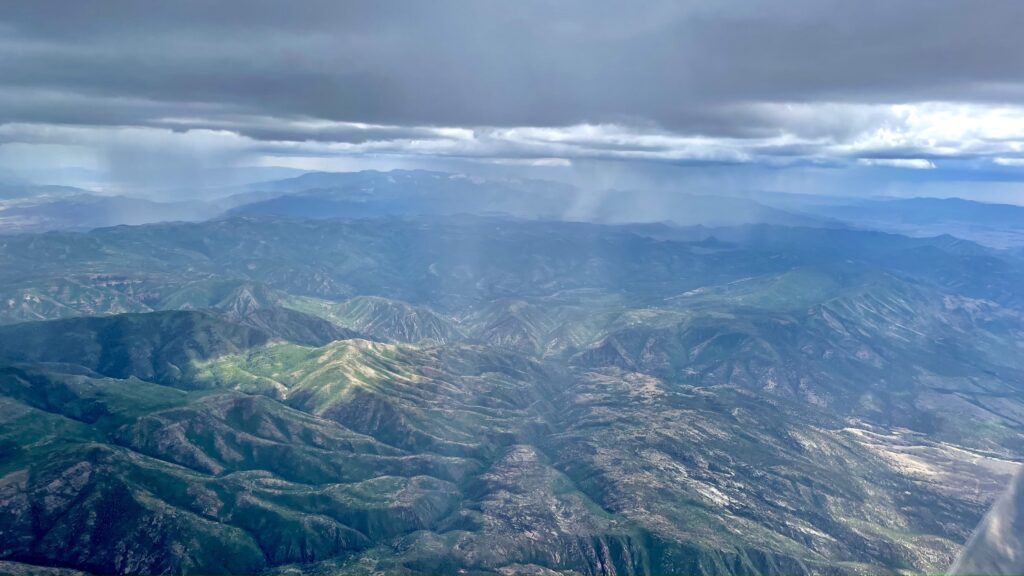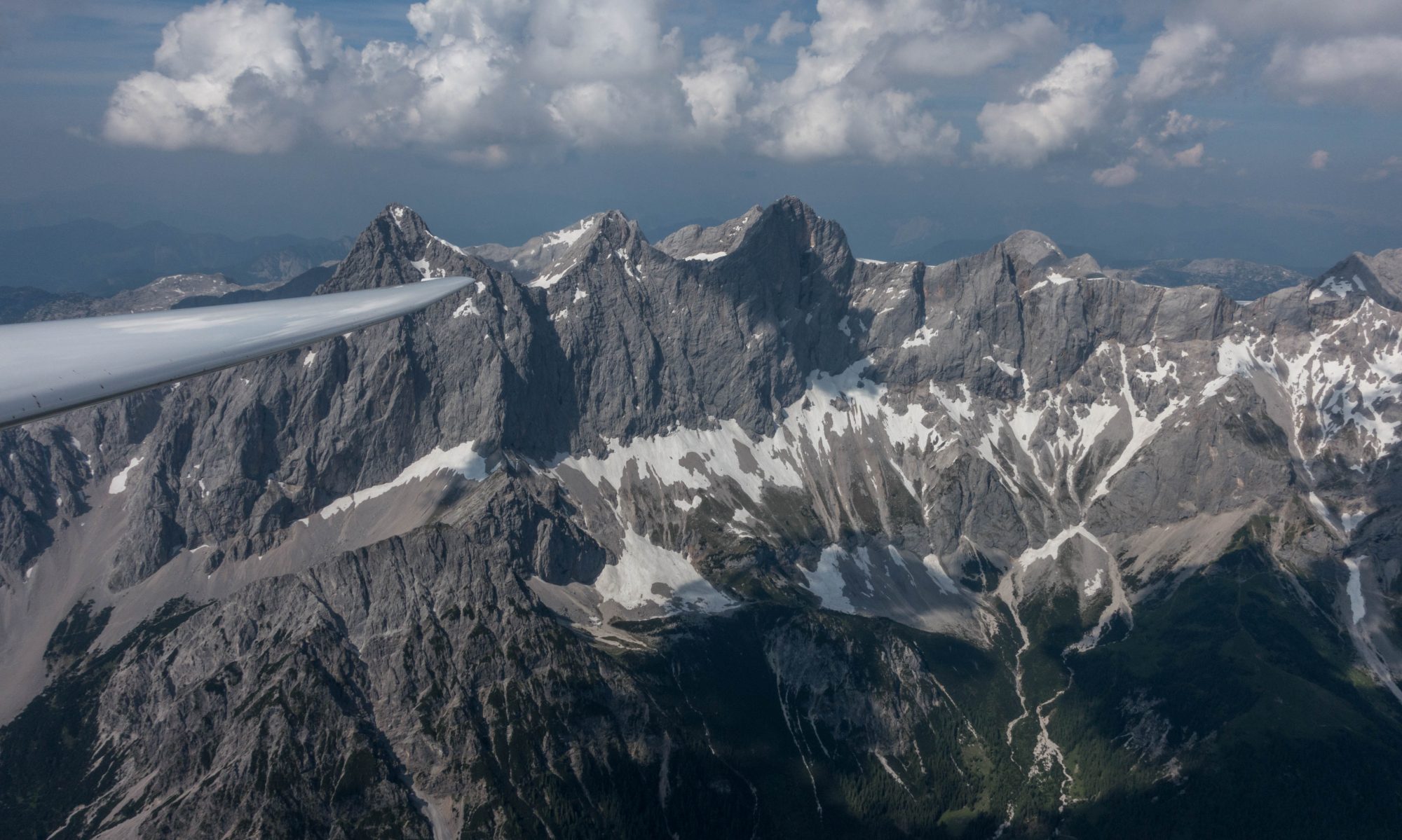
Day 2 was a day of contrasts at the 18m Nationals and Region 9 Sports Class Contest. The 18m class was sent off on a three hour minimum Assigned Area Task (AAT) with three 30 kilometer turn cylinders at Crispy, Drum Mountains, and White Pine Peak.
Skysight predicted very strong conditions along the airmass boundary separating the western desert from the ridge lines of the Rocky Mountains. The task looked like a triangle but one could almost turn it into an out and back race to take full advantage of the lift line along the Pavani Range. To do that one would have to go deep into the first turn cylinder near Mt Delano in the Tushar Mountains, then backtrack north, head west and nick the second turn area, only to return to the mountains and go deep again in the third turn cylinder before heading back north again towards Nephi along the same line.
This would minimize the time in the blue and maximize the time spent flying straight under the cloud shelf marking the convergence.
I suspect that many pilots had similar ideas for the day and one of my pre-take off concerns was the back and forth traffic along the same cloud street. The sky is a big place but all soaring pilots look for the best lines of lift as marked by the clouds and that can lead to high-speed head-on traffic along the same routes and at similar altitudes.
John Seaborn, the defending 18m Champion and yesterday’s winner confirmed my thoughts but added that the best laid plans usually go the way of the waste bin as soon as one gets a look at the sky in flight. How right he would be.
After some start delay with the usual intense pre-start gaggles the first leg looked just as promised. But this only held until Filmore, about two thirds towards TP1. The further south we went the darker the skies became and my plan to get almost to the Tushars went by the wayside as soon as a pilot ahead reported lightning strikes near Mt. Delano. Storm clouds can produce amazing lift but they are not my cup of tea. I watched the leaders head into the dark overcast, flying between rain shafts and decided that this wasn’t for me. I only nicked the turn cylinder and instantly new what this meant: I had to alter my strategy and go much deeper into the western desert than I had intended – otherwise I would finish well below under minimum time.
Fortunately there were some good clouds along the first part of that third leg until the Big Blue Hole appeared that Skysight had forecast. The next clouds were perhaps 40-50 kilometers away, over a line of hills in the distance. I tanked up under the last cloud and then went out into the desert, dialing my speed back to 80 kts. By now the leaders who had flown deep into TP1 caught up to me and so I had some company. At this point this was quite welcome for I knew the pilots in front would mark any good lift ahead.
However, the air across much of the blue hole turned out to be completely still. I could have let go of all controls and the glider would have flown on its own. There was even time for contemplation. Flying a glider usually involves rapid decision making, with decisions often taken every few seconds. But now I flew over flat, largely featureless desert. I had pointed the glider to the next clouds and all I could watch was the variometer for any indication of lift or sink to make small adjustments to my glide path. For some time there was neither. My altitude slowly trickled away but the task setters had done us a huge favor by setting a course that would allow us to keep Delta Muni in glide.
By the time I reached the next clouds I had only used up a bit more than 3000 feet of altitude. It’s amazing how efficient our machines are in the air. Fortunately the clouds on the other side worked reasonably well. In hind-sight I was a bit too conservative accepting mediocre lift at first before I gained enough confidence that the sky ahead was indeed working. I passed the center of the Drum Mountain turn area and carefully paid attention to the restricted airspace, which is used by the air force for fighter training. I got to know a former F16 pilot who had been stationed in Utah – you definitely want to stay well clear of that area even when there are no contest points on the line!
Once my flight computer showed a good amount of overtime even when I would only nick the last turn area, I turned and largely back-tracked the path I had just taken, heading back south-east. More clouds had developed and the blue hole had shrunk considerably, making the transition a lot easier.
Going deep into the second cylinder turned out to be a good decision because heavy rain started to fall in the third cylinder just as I go there. I had to cross a virga line to get into the turn area but then I found strong lift just to the west of a rain shaft that I flew around once I decided that it was time to turn back to Nephi. You could see the gust front from the rain driving up dust on the ground – often a great indication of where to find lift.
A line of clouds across the Canyon Mountains marked a good line towards Nephi and I went on final glide even though my flight computer predicted that I would be 500 ft too low at MC4. The lift over-delivered and I kept increasing my speed to 125 kts and still arrived almost 1000 ft too high.
That turned out to be a blessing because dozens of gliders arrived within minutes of one another. It was hard to find two to three seconds of free radio time to announce my arrival among all the finish announcements and sorting out of the landing sequence. Amazing how this works without air traffic control. However, instead of diving right into the traffic jam I climbed back up to cooler temperatures and waited until the commotion on the ground had settled down.
Oh, results. I guess I’m in a competition and these things should be reported. My average speed for the day was 130 kph just like on Day 1. Not fast but a modest improvement in relative terms because today’s winner, Robin Clark, averaged 161 kph, which means I scored just a little over 800 points. Not great but not terrible either. I have realistic expectations and am here to learn and not to win.
Flight trace on WeGlide: https://www.weglide.org/flight/79587
Flight trace on OLC:
Contest Results on SSA Website: https://members.ssa.org/ContestResults.asp?contestId=2486…

